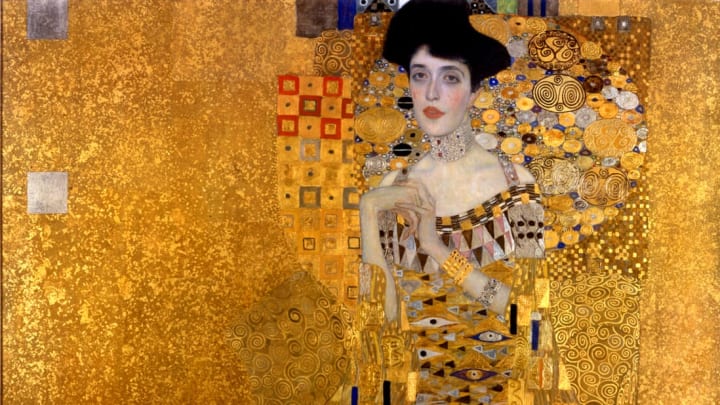Gustav Klimt at 100: Painter. Photographer. Dress Maker.
By Editorial Staff

Mental Floss has partnered with FOTO, a visual storytelling platform from Getty Images, to bring you articles featuring stunning images from Getty's archive.
The famously erotic, semi-psychedelic, sometimes gold-leafed paintings of bohemian artist Gustav Klimt once scandalized Austrian society. Today, of course, they’ve become museum-shop staples and dorm-room must-haves. The Austrian painter, who died 100 years ago, was known for his sensual portraits of women wearing shimmering, swirling dresses, but less so for the creative—and possibly romantic—partnership that brought the dresses to life.
MORE THAN COLLABORATORS?
The dresses now so closely associated with Klimt's work were a collaboration with Emilie Louise Flöge, a Vienna native Klimt met when she was just 18. Until Klimt's death in 1918, Emilie remained a close companion and perhaps a lover, and was a groundbreaking fashion designer with a radical streak in her own right. (Pictured: Emilie and Klimt in 1910.)
THE SISTERS FLÖGE
Klimt met Emilie after his brother married her sister—and then promptly died. Klimt was left to care for the widow, which allowed him to spend plenty of time with the family Flöge and young Emilie. (Pictured: The three Flöge sisters, with Emilie at the far left, and Klimt in a rowboat in 1910.)
HUMBLE BEGINNINGS
Emilie began her climb in the fashion world by working as a seamstress at her sister’s dressmaking school in Vienna. In 1899, the sisters won a dressmaking competition and went on to design a dress for a widely attended exhibition. (Pictured: Emilie, as painted by Klimt in 1902.)
DESIGNING WOMAN
Emilie, presumably in a dress of her own design, in about 1910.
UP THE FASHION LADDER
Emilie quickly established herself as a savvy businesswoman, opening Flöge Sisters, a haute couture fashion salon in Vienna. She traveled to Paris and London, studying the work of designers like Coco Chanel and Christian Dior, among others.
WORKING TOGETHER
Many of the dresses that appear in Klimt's most celebrated works were created in concert with Emilie: He designed the patterns, she the fabric and cuts.
KLIMT BEHIND THE CAMERA
Klimt took many photographs of these collaborations. Emilie's designs were influenced by the early Feminist movement: They were flowing, comfortable clothes for women (no corsets!) that hung loosely from the shoulders. In this picture by Klimt from 1906, Emilie wears a dress she designed.
CLASSIC IMAGES
Even with referrals from Klimt, who was at this point painting portraits of Vienna's high-society women, sales of Emilie's revolutionary fashions were not brisk. Here, Emilie as photographed by Klimt in 1906 or 1907.
SKY-HIGH SALES
Klimt was quite successful, but no one could have predicted how sought-after his works would eventually become. "Adele Bloch-Bauer II," pictured above and one of Klimt's most famous paintings, was a portrait of the wife of a wealthy Klimt patron. The Nazis snatched it from the family home during WWII but in 2006, the work was purchased at auction for nearly $88 million. The buyer? Oprah Winfrey, who eventually sold it for a reported $150 million.
For more Klimt photos, visit FOTO.
See Also...
Paris Museum Lets You Stand Inside Your Favorite Paintings
*
Mesmerizing Murmurations
*
Picasso: Memorable Quotes from a Master of Modern Art